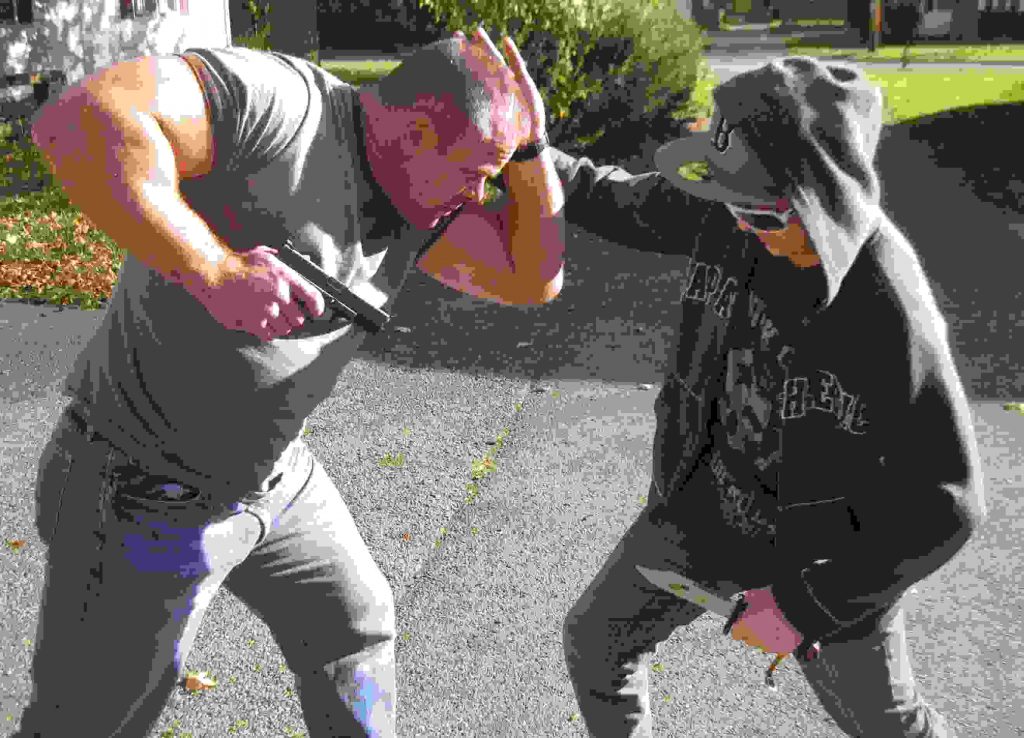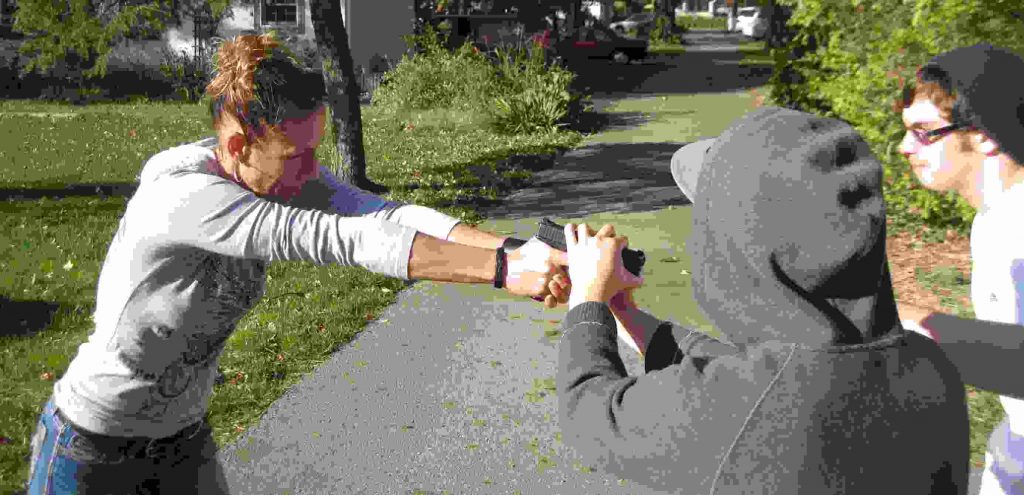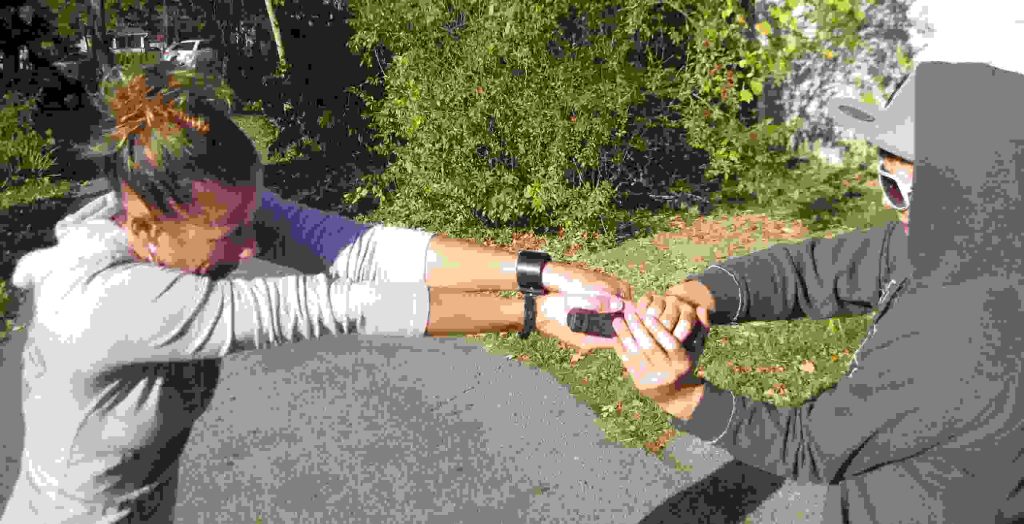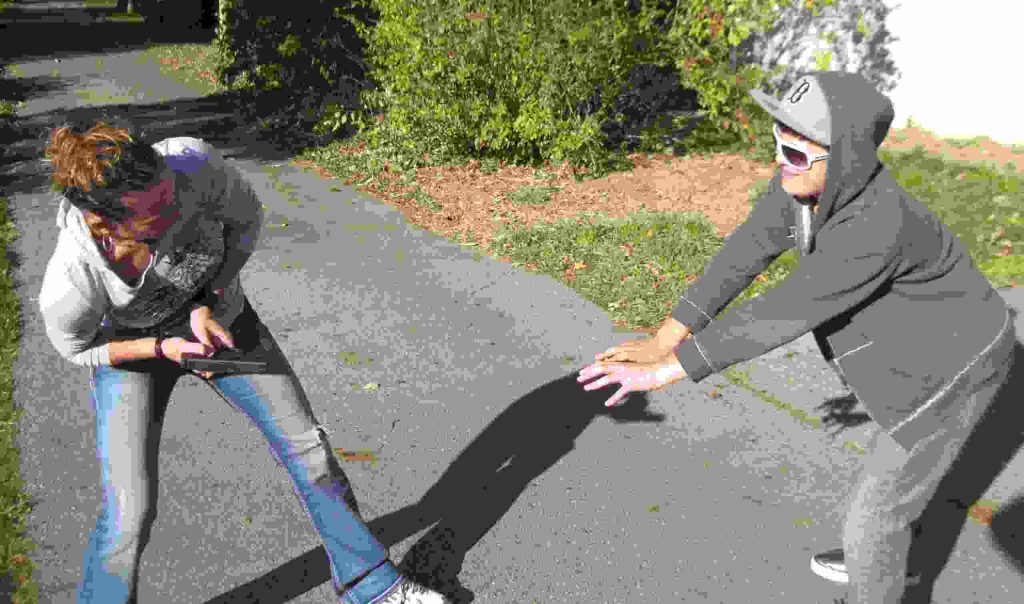
When surrounded by a mob, extended shooting stances become problematic.
Violent protests, mob action, and rioting scenarios fill up your news feed. Lots of folks are contacting me about mob violence issues. Let’s look at some of the issues involved…
To date, the majority of mob violence events have occurred in very large public gatherings and at the sites of large political protests. Like many criminal attacks, there are often warning signs that an aware person should notice. Mobs grow quickly, but a person who is aware of his surroundings and has a plan should be able to stay one step ahead of the mob.
Trust your instincts and pay attention to what’s going on around you. When you see people amassing, it’s time to move out. Most of the injuries caused by rioting don’t have to happen. Resist the urge to stand around and watch the mob’s display. Things can go from fun and lighthearted to exceedingly violent very quickly. Always have an evacuation plan for every location you visit. Your plan should have at least two alternate ways to get out of a violent crowd. When you see the crowd gathering, implement your plan. Get out. Don’t wait around to be a victim.
The urge to watch a chaotic public event is almost impossible to resist. Everyone wants to see what will happen next, without realizing how close they are to actual danger. The risks cannot be overstated. When you see a violent crowd forming, leave the area.
I’ve responded to some violent crowds in my career as a police officer, I’ve personally been present during several violent riots and mob actions during my travels in South America and Africa. I avoided death and serious injury in each of these events because I acted quickly to escape the violence.
The need for quick thinking and escape may be obvious to you the reader, but would you ascribe the same quick decision making process to your spouse or your children? Children and teens may not have the knowledge or experience to associate massing people with violence.
Do your children a favor. Get on the internet and find some videos of violent mobs or rioting. Show your children how dangerous these situations are and teach them how to get away quickly. If you look at such videos, you’ll likely see many teenagers filming the violence with cell phones. They have no idea how much danger they are in.
Make sure your children know how to escape crowd violence. Teaching them to escape is a much better option than letting them hang around violent crowds trying to create the next big TikTok video hit.
In addition to teaching your family to get away at the first sign of violence, you should also make sure that your family members have the ability to escape. I rarely see children and teenagers wearing “real” shoes during the summertime. Almost all young people, both males and females, wear sandals or flip flops as soon as the weather starts to get warm. Flip flops are not suitable for running away from a violent crowd. Make sure that if you or your family members attend a large public event they wear shoes (and other clothing) that facilitates the ability to run if necessary.
When attending any large public event, you and all of your family members should establish at least two emergency meeting locations, one within the event perimeter and one outside the event. If you and your family members are separated and cell phone service is disrupted, you should know how to meet back up. It may also be a good idea to equip your children with spare car keys, even if they can’t drive. A natural meeting place is the family car and you will want your children to be able to seek shelter inside the car if you haven’t yet arrived.
If you are together with family members when you encounter a violent mob, don’t assume that your family is seeing the same things that you are. You may have to tell them what is going on as you implement your escape plan. You may not have the time or desire to explain your perceptions of danger to very young children.
I would recommend that you implement a code word procedure with your young children and work it into regular emergency drills. Choose a word that you don’t commonly use. A word like “emergency” works well. Train and drill your children to instantly and unquestioningly obey your commands after the code word is given. Saying something like: “Emergency! Run to the car!” and having your children actually obey your commands without question is a useful tool in an encounter with a violent mob.
One other important consideration in protecting family members is to train them what to do if you have to pull out your concealed firearm and shoot. One of the primary reasons many people carry firearms is to protect their family from violence. Something that every person should consider is the question of how to best protect family members once the firearm comes into play.
In a potentially lethal situation, many shooters will draw their firearm and order their family members to stand behind them. Is that really the safest place to put your family?
If you are drawing your gun, you most likely are anticipating an armed attacker or attackers. You will be the focus of their force. When the attackers see your gun or recognize that you are firing on them, they will shoot back at you. The most dangerous place for your family to be is anywhere near your location.
Personally, I have trained my loved ones to unquestioningly obey my commands if I ever draw my weapon in public. If I do not give them commands, they are to get as far away from me as possible as soon as the guns come out. I can protect them best by drawing fire away from their location.
Before drawing a firearm, make sure you have exhausted all other options. Using a firearm in the middle of a panicked and violent crowd is almost always a bad idea. At best you will hit your target and stop the immediate threat, but cause further panic and chaos in an already bad situation. At worst, you could get your pistol taken from you, miss your target and hit an innocent person in the crowd, or even be mistakenly shot by the police or another CCW permit holder.
Consider carrying and using small impact weapons or pepper spray (OC) for most threats. It has been my experience that the assailants who comprise many mobs are not all that motivated. When they encounter victims who provide a little resistance, they quickly move on to other less dangerous targets. A quick blast of pepper spray will likely dissuade a lot of flash mob violence. I’ve found Sabre Red and Fox Labs pepper spray products in a stream or fog formulation to be the most effective. With that said, lots of these rioters are wearing gas masks, respirators, and eye protection. They came to the party expecting pepper spray and may not be affected by yours. Don’t discount Kubatons, flashlights, or canes as alternate weapons to use in the crowd.
Although there are tremendous public perception issues involved with using a knife for self defense, the knife may be a better tactical solution to the problem of lethal crowd violence. Since flash mob violence is generally a short range affair, the knife’s lack of range isn’t such a detriment. The knife will not overpenetrate and hit someone else, is more difficult to take a way than a firearm, and never runs out of ammunition. It is also less likely to draw police attention or panic the crowd.
Don’t draw your firearm unless you truly anticipate the need to fire. It is common for CCW permit holders to draw their weapons at the first sign of threat or violence. In many cases that would be good practice. Not here. It is difficult to maintain good control over your firearm when it is in your hand as you move through a crowd. People will be bumping into your gun arm and hand or may even attempt to take your weapon. The gun causes the crowd to act even less predictably, which could make your escape more difficult.

If you have to draw your weapon, keep it close to your body and hidden from view as best as possible.
Additionally, police will eventually be responding and may be quick to shoot a person seen carrying a gun while in a crowd of violent rioters. Sometimes, when crowd chaos is at a high level it is difficult to differentiate between an armed CCW permit holder trying to protect his family and a rioting criminal. Play it safe, be ready to draw, but keep the gun holstered or hidden until you are sure you’ll need it.
If you do have to fire your weapon in a crowd, do so from a good retention position. In a retention position, the goal is to avoid extending the firearm within your assailants’ reach. It is just too difficult to maintain control of a pistol during a physical fight if the pistol is held at arm’s length.

It is better to fire from retention. Note aggressive forward posture, gun anchored to chest and off hand up to block or fend.
Pull the gun back and touch the grip to your gun-side chest. The barrel should be roughly chest level and parallel to the ground or at a slightly downward angle. Your non-shooting hand should be up to protect your head from punches, thrown objects or impact weapons. At ranges less than 10 feet, you can make very accurate hits from this retention position without the concern that someone will strip your pistol from your hand.
Try shooting from this position in your next practice session. It takes a little fine tuning and adjustment to get used to it. Make sure that you are holding the gun in such a manner that the slide can reciprocate without hitting your chest or catching your clothing in the ejection port.
A solution for people who lack the shoulder flexibility to really pull the gun far enough back is to tilt the gun outward. Rotate the gun hand so that the palm starts to face upward. That should move the slide out away from the body enough to allow it to move back and forth. The outward rolling is also useful for a left-handed shooter who is creating malfunctions when the ejected case bounces off the chest and gets thrown back into the ejection port.
After you have fired a few rounds from this position, begin to work from the holster. Draw your gun into this position and fire again. A good drawstroke should already be moving through a position like this anyway. The retention position is where the gun should be located if your drawstroke was stopped before your two hands meet.
You will likely feel some hot gasses hit your face if you are doing everything correctly. Don’t get in the bad habit of leaning back or extending the gun forward to avoid these gasses. Both adjustments compromise your retention position. Stay leaning aggressively forward with the gun pulled back into your body. You’ll quickly get used to the feeling of the gasses and it won’t be an issue. It should go without saying that you shouldn’t try this technique with ported or compensated guns!
If the worst happens and you find yourself the target of a gun grab, you will need a simple technique to retain the pistol. Shooting the criminal who grabs your gun may be a legally justifiable tactic, but it may not be possible. He may have averted the muzzle from his body, blocked your trigger guard or taken your slide out of battery during the grab. If any of those situations occur, you will be unable to shoot the attacker.

Try this. Violently twist the gun in his grip so that your gun hand palm faces upward. Then take a large step back, ripping the gun from his grip in a downward motion. Don’t just tug on the pistol using the strength of your arms. Use your entire bodyweight and the momentum created by stepping backward to sharply accelerate your pistol down and to the rear.

Twist the gun so that your shooting hand is palm-up

Then pull violently down and back with all of your body weight.
Even if your attacker is larger than you, the technique will generally work. The initial twist slices his hand with the front sight and loosens his grip. The pulling motion dislodges the pistol from his grasp. After you pull your pistol free, perform a malfunction clearance procedure because the gun may have become jammed in the struggle.
Good awareness. Escape planning. Less-lethal alternatives. Weapon retention skills. It doesn’t take anything more than superior execution of these few basic concepts to prevail over the violent flash mob. Devise a plan for the next crowded public event you and your family attend and work a few of these skills into your next practice session. If the trend of increasingly violent crowd behavior continues, you’ll be glad you did.

